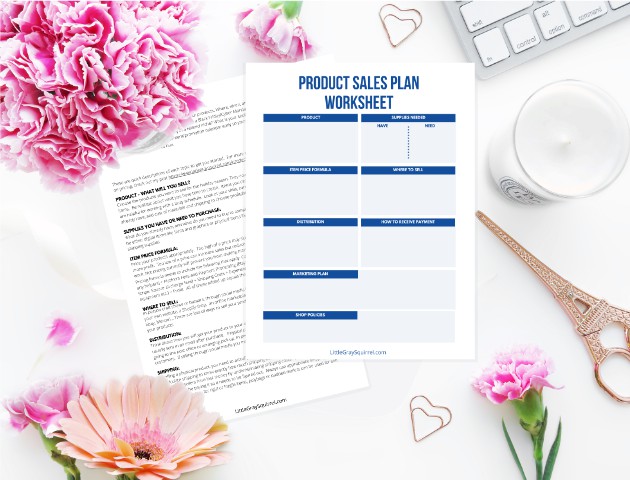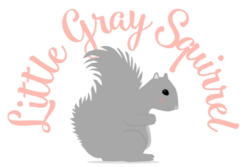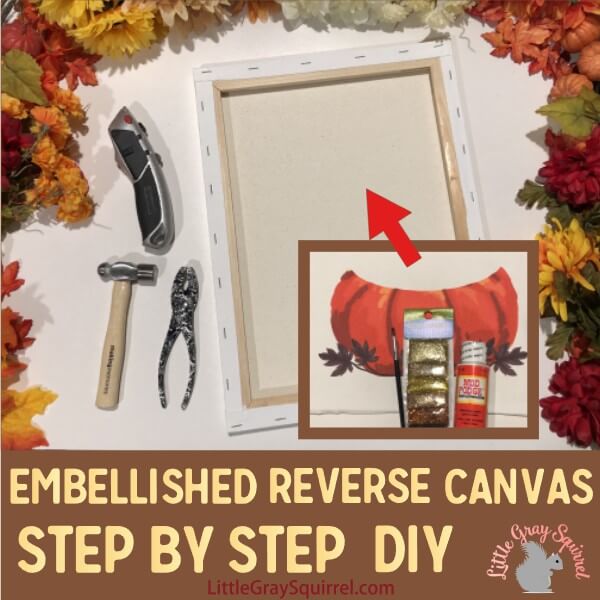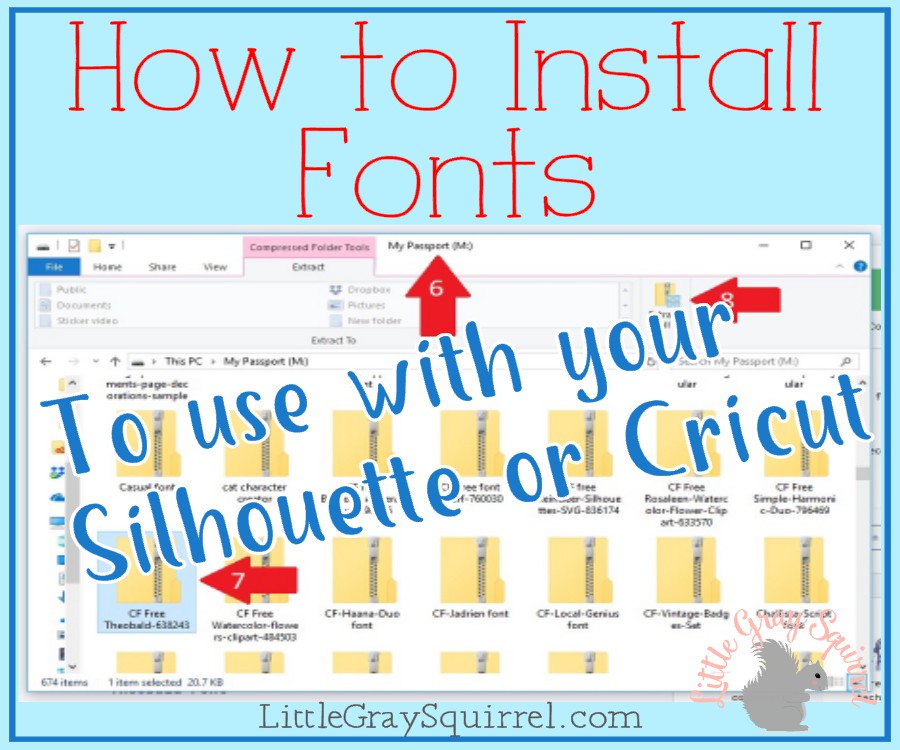
Product Sales Plan Worksheet
Product sales guide and worksheet to help crafters and makers plan your digital or handmade product for an upcoming holiday season or product launch.
This will help you map out what product you will create, what you need to create it, and how much to sell it for. It also includes tips and important things to consider when selling your products.
**This post contains affiliate links. When you click these links I may make a commission on purchases made through those links. As an Amazon Associate I earn from qualifying purchases.** Please read our disclosure policy for more information.
The worksheet and guide is free for my email subscribers in my Resource Library. You can join, and get it here. Or fill out the form at the bottom of this page.
I wanted to compile these tips and create a worksheet because if you haven’t sold anything online, these are some really important things to consider.
I don’t want to get too specific for this post because there could be (and are) entire books written on each of these topics. This guide and worksheet is mostly to help you create a plan and think about things that you may not have considered.
You may need to do further research on specific categories.

What do you need to do to sell your products?
Print out the worksheet from my Resource Library or grab a notebook and answer each of the topics below.
Product:
What are you going to sell?
Decide on the products you want to sell. Are they digital or physical items.
Be realistic about what you have time for to create. Items you can create ahead of time are helpful for working with a busy schedule.
Look at your skills, current trends, supplies you already have, and cost of materials and cost of shipping the item to choose profitable items to sell.
Supplies:
What do you already have, and what do you need to buy to complete the products.
These can be either digital items like fonts and graphics or physical items like craft supplies, tools, or shipping supplies.
It is important to know how much of each item you need so you have enough and also so you can price your product appropriately.
Even if it is a supply you already have, you need to include the cost of the supply when pricing the product (more on pricing below).
Where to sell:
You should decide where you will sell your products before you decide your price because different ways of selling can cost a different amount.
You can sell at in-person craft shows or bazaars, through social media like Facebook, Instagram, or TikTok, your own website, a Shopify shop, an online marketplace like Etsy, Creative Market, Amazon, Ebay, Mercari… There are lots of ways to sell your products, chose the best one (or more) for you and your products.
If you sell in more than one place, or plan to sell somewhere later that costs more, use the fees of the more expensive location when pricing your product.
Platforms like Etsy, Amazon, Ebay, Shopify etc. charge fees and selling at a craft show or in a shop will have fees too which could be a flat fee or a percentage of sales, or a combination of both.
Item Pricing Formula:
It is important to price your products appropriately. Too high of a price may slow down sales but you will make more profit. Too low of a price can increase sales but reduce your profit and cause you more work.
Not pricing your product correctly will prevent you from making money.
Digital products are priced differently than physical products.
Since I like numbers and I love pricing things out (mostly recipes but craft products are similar), I will go into some specifics for this.
These are the things I factor in when pricing physical products. I will explain a little about digital products below.
There are some very generic pricing formulas out there like cost of materials X 5 but if you are just starting, the more you understand about your expenses, the better you will be and you will be profitable, much sooner.
Pricing Physical Products:
Your price needs to include the following:
- Cost of supplies (the things that are used up in creating the product)
- Cost of Labor (yours and any helpers)
- Platform Fees or location fees
- Payment Processing Fees (some platforms like Etsy charge payment processing separately) Paypal, Stripe, Square etc. all charge fees for each transaction. It is usually a percentage of the sale price + a flat fee.
- Shipping Costs (include cost of supplies and actual calculated shipping).
- Expenses (overhead, business taxes and insurance, equipment, office supplies, software, sand paper, saw blades, the things that cost money that aren’t cost of supplies listed above)
- Profit
All of these added up equals your product sales price.
You should know what your business expenses are but you can also estimate and use a percentage.
Add up your monthly expenses and divide by your sales amount to give you a percentage. Then when pricing your product, use that percent as your expenses. Reassess your expenses quarterly to make sure it is still accurate.
Example: If your expenses are $150 per month and you sell $1,500 worth of products, your expenses are 15%. So if you price your product at $48, that means for every product you sell, $4.80 goes towards your Expenses. Selling 32 signs from the example below would make $153.60 for your expenses.
So for the whole product pricing formula for a $48 wood sign it might look something like this:
12″x12″ Wood Sign: $48 (“free shipping”/shipping included in list price)
Cost of supplies: 12″x12″ Wood $3.35 + Paint $2.00 + Vinyl stencil $0.65 + Hanging hardware $0.25 = $6.25
Cost of labor: 1 hour $15/hour = $15
Platform Fees: Listing Fee .20 + Transaction fee 5% (including 5% on shipping if customer pays it on top of purchase price) = $2.60
Payment Processing Fee: about 3% + $0.25 = $1.69
Shipping Cost (don’t estimate!): $15.20 (less if you use Etsy, Ebay, or USPS online discounted rates)
Expenses: 10% = $4.80
Profit: $2.46
After you sell a few things and get an idea for your averages, you can use percentages instead of exact dollar amounts except for cost of supplies, labor, and shipping.
So to simplify, for the $48 sign it would be:
Cost of supplies: $6.25
Labor: $15
Shipping: $15.20
Platform and processing fees: 10%
Expenses: 10%
Profit: 5%
Time to get a little mathy…
To figure your sales price from the three actual dollar amounts you have (supplies, labor, and shipping) and the added up percentages (platform and processing, expenses, and profit), using the example above, the dollar amount of your costs is $36.45 and the percentages equal 25%. So you need to figure out what number $36.45 is 75% of (the difference between 100% and 25%).
Multiply the dollar amount by 100: $36.45 x 100 = 3645
Divide that number by 75: 3645 divided by 75 = 48.6
So your product sales price is $48.60. You can round up or down or leave it as is.
I prefer to include shipping in my sales price. If you don’t want to include it, I suggest you include it to factor the price and then subtract it vs. not figuring it in the formula and then adding it. This will give you more margin or cushion in your pricing and account for gas for driving to the post office, shipping supplies, and labor to ship.
For example, you can charge $33.40 and charge for shipping separately but remember you will have to pay $0.76 to Etsy for their 5% fee on shipping transactions.
If you had not factored the shipping in first, your added dollar amounts would have been $21.25 x 100 / 75 = $28.33 + $15.20 = $43.53
Don’t set your prices too low. You can always lower your price, run a sale, or offer a coupon. I prefer to estimate my own price and then look at competitors to see where I fit in.
Don’t undercut other sellers prices because you don’t think you are worth it for whatever reason.
I challenge you to figure out your price, multiply it by 25% and add that and see how it sells. You may surprise yourself. So instead of a $48 sign, you have a $60 sign. The difference usually comes down to better product photos, descriptions, and telling people about it, not the quality of your product.
Pricing Digital Products:
This is going to ramble on a bit because it can vary quite a bit but really comes down to a personal choice.
You still need to consider platform and processing fees, and profit when pricing digital products but your business expenses, labor, and cost of supplies are handled differently, and you don’t need to worry about shipping.
The upfront labor of creating a digital product is offset by the lack of labor needed to create and fulfill the digital product order when it sells and that the product can be sold over and over.
Typically after you create a digital product and list it, you don’t need to do anything else unless you have a customer service inquiry to take care of.
So if it takes you 1 hour, or 20 hours to create a digital product, you don’t need to account for that from the sale of just one item, it can be spread out over many sales.
Using a font with an expensive license will also be spread out over many sales (just make sure you are compliant with the number of sales allowed by the license). TIP: Using fonts that are not available all the time for free and cost more than most fonts is a great way to differentiate your products from someone that uses free fonts (with commercial use).
To price a digital product, I consider these things with product itself.
How trendy is the product? A very popular product will sell more than something that isn’t. You could price a popular product slightly less and make more sales/more money.
How much competition is there for a similar product? Unless your product really stands out, you should really consider competitors pricing. Don’t undercut but compare it.
How often is it purchased? If it is an evergreen product, something that someone would purchase any time of year like something for a birthday or baby shower and not holiday related, you could get sales year round so you could price your item lower, expecting more sales.
If it is an annual purchase like a planner, holiday related or seasonal, you could have a lot of sales for a few weeks or months of the year. So you can price the item higher.
For seasonal products you can price a little higher because they are shorter lived and people tend to pay more for holiday items.
People buying for weddings can be more particular so wedding related products might command a higher price.
What is included in the product? Is it a single page printable or single cut file? Those are typically priced less than if it is a bundle of files or a whole ebook or planner type product?
Is it a personalized item? There are personalized digital products. You will want to figure how long it takes you to personalize the product every time it sells, multiply that time by your labor rate, and add it to your price.
Is it something they buyer can use to sell something? Will you offer commercial use or just personal use? A product that someone will use to make money is usually sold for a higher price.
I look more into competitor pricing for digital products than for physical products because digital products can be more comparable, you can get an idea of what things are selling for and the cost of creating it is similar. Yes, you should still determine your own pricing because your business is not the same as someone else’s.
Some differences between your shop and someone else’s could be; the number of products they have for sale, the quality of the product, the content, popularity, do they pay for ads… High volume shops can charge less and be profitable.
Selling high volume does not have mean you have lower prices though.
TIP: Try to set a minimum price for your products and combine products to reach that minimum. $4-$5 is a good minimum price for a digital product because there is still some profit after fees. $2.99 might be OK if it is something simple to make and sells in high volume because you probably only make about $2.30 after fees (not including expenses). You would only make about $1.30 on a $1.99 digital product selling on Etsy.
So to increase your sales price, maybe you could add to the product or combine a couple of products to give that product at least a $5 value. If you are selling digital cut files, think of how you can group some to get to a $5 price or offer a choice of a 2-3 products from your shop for $5. Selling a digital product for $1-$2 will leave you with very little profit after fees.
Distribution:
How you will get your product to your customers.
Digital downloads are simple and usually sent in an email after purchase.
Physical products require space to pack the item and taking them to the post office or arranging pick up.
In person events are easy to sell directly to customers.
If you are selling through social media you may need to figure out shipping on your own.
Shipping:
If you are selling a physical product, you need to actually package your product, weigh and measure it or see which flat rate box it fits in to calculate shipping to know exactly how much shipping will be and the shipping supplies you need.
Many sellers have lost money by underestimating shipping costs. Either you or your customer will be paying it so it needs to be figured out.
Always use appropriate shipping materials. Use a box and packing materials for rigid or fragile items. Padded mailers or poly bags can be used for soft goods.
For products that weigh less than 16 ounces, I usually ship USPS First Class. For items over 16 ounces, I try to plan for products that will fit in USPS Flat Rate Priority packaging. This is because the Priority shipping boxes, envelopes, or padded mailers are free and it doesn’t matter how much the item weighs (under 70 pounds), as long as it fits, it ships. It also ships quickly.
I prefer to add shipping to the price of my item rather than charge separately. This is for a few reasons. One, the customer knows their total when choosing the item they want to buy, they won’t decide not to buy it when they see it will cost them $X more for shipping. And two, if there is a discrepancy in the shipping cost, for example it cost $1 less to ship than I originally planned, if the customer were to find out how much the shipping actually cost, they wouldn’t be upset because they didn’t know how much shipping was supposed to cost. Whenever possible, do not put cost of shipping on the label. Buying online you can choose to not have it on there, when you buy in a post office or retail store, it usually is printed on the label.
Important: Always ship within the time frame you state in your shop policies. If for some reason you can’t, contact your customer immediately and let them know. Since it isn’t what the customer was expecting, you should give them the option to cancel their order if they will not receive it on time.
Properly planning your shipping costs should prevent this, but if you say you will ship Priority, you need to ship Priority. You can upgrade First Class to Priority, but don’t downgrade from Priority to First Class to save you money. It can make your customer upset.
Marketing Plan:
How will you promote your products. The difference between someone who sells their products and someone who doesn’t is usually just because the person who sells their products tells people about their products. The person who doesn’t, doesn’t.
Be consistent and deliberate with your promotion.
Where, when, and how will you promote your product?
Will you offer coupon codes or have sales?
Will you have a Black Friday/Cyber Monday sale?
Will you pay for ads (factor that expense into your pricing if you do)?
Collaborate with a company in a related niche?
What is your social media strategy?
Plan your content/promotion calendar early so your customers know about your products in time to buy. It usually takes someone seeing something a few times to decide to buy it. I have read that it can take 5-7 times before someone actually purchases. So showing someone something one time on one of your social media accounts is not enough.
Don’t forget to include a call to action (Buy here! Get yours here!, Add to Cart!, Order Here!, Order Now! are all examples of a call to action)
Don’t assume people can figure out how to buy from you.
Tell them exactly where and how they can buy from you. Add a link directly to where they can purchase. Not just a link to your website or Etsy shop, a link directly to the product you are promoting.
How To Receive Payment:
If you sell at an in-person event, will you use a card reader, QR code that links to your payment processor, send an invoice, accept cash? Make sure you are using an app that is approved for business transactions to protect you and your customer.
Payments through an online marketplace (like Etsy) are handled for you but you still usually need a way to receive payouts from the marketplace. This could be a bank account, PayPal, a physical check… Different payout methods can have fees so make sure you choose the right one for you.
If you sell online or through social media, you will need to choose a company to process payments through.
I have used PayPal for at least seven years and have been happy with it.
If it is a custom made item get at least 50% non-refundable deposit or 100% of the sales price before you start the order – you are worth it! Paying for a product before someone receives it is normal. Some “customers” would like to try to tell you otherwise but they are most likely not someone you would want to have as one of your customers.
If you are selling through your social media. Make sure you receive payment before you ship or deliver an item.
Shop Policies:
Handling time, order cutoff dates (add extra days for shipping, the past year has been really bad about getting packages delivered on time and this holiday season will probably be the same), and returns (how they are handled, if they are allowed), should all be in your shop policies.
Also include payment requirements if you do custom work.
Your shop policies need to be available for the customer to read before they place their order.
Additional Tips:
Create a realistic (as possible) schedule and map it out on a calendar.
Create a goal and write it down. Give plenty of time to create, market, and distribute your products and have time for personal plans and other work that needs to be done.
If you don’t have one already, set up a system of collecting email addresses from your customers so you can let them know about future products and sales.
Take quality photos of your products in good lighting in a styled setting to use in your posts and listings. Only use image mock-ups if it is a product you have made before. Typically I only recommend mock-ups for digital products.
I hope these tips help you get started thinking about things to consider when it comes to selling products you make.
Best, Megan
[mailerlite_form form_id=9]




